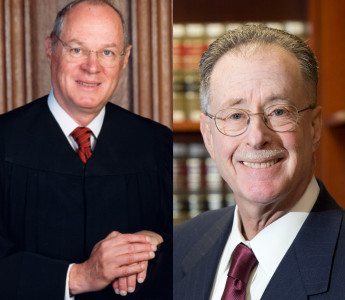June 11, 2017
Kokesh v. SEC, 581 U.S. ___ (2017) (Sotomayor, J.).
Response by Theresa A. Gabaldon
Geo. Wash. L. Rev. On the Docket (Oct. Term 2016)
Slip Opinion | SCOTUSblog
Kokesh v. SEC: SEC Actions for Disgorgement Are Subject to a Statute of Limitations
Since its inception in 1934, the Securities and Exchange Commission (“SEC”) has wielded statutory authority to seek injunctive relief for violations of the federal securities laws. Since 1970 courts have, at the Commission’s behest and without much analysis, ordered violators to disgorge profits—make that lots and lots of profits—gained in the course of their wrongdoing. In some instances, the profits are returned to victims. In others, either because the victims are too many and too scattered or because the violation is a victimless one such as engaging in bribery, the government keeps the ill-gotten gains. In either case, the existence of the disgorgement remedy has been regarded by the lower federal courts as well settled enough so as to result in SEC disgorgement recoveries of over $3 billion in 2015 alone.
During the period that the Commission has successfully pursued disgorgement actions, Congress has extended its enforcement authority several times. The SEC now is specifically empowered to (among other things) issue cease-and-desist orders, seek industry bars against certain violators, and, quite generally, seek civil monetary penalties for violations of the laws it is charged with enforcing. Notably, it is typical for each legislative expansion of SEC authority to specify there is no intent to limit the power to pursue other remedies, ritually reciting something like, “[t]he actions authorized by this section may be brought in addition to any other actions that the Commission . . . [is] entitled to bring.”1
Occasionally, Congress has specified a statute of limitations for a particular remedy. For the most part, it has not. The federal courts easily determined that the SEC’s general authority to seek civil monetary penalties was subject to 28 U.S.C. § 2462, a catch-all statute of limitations requiring that “enforcement of any civil fine, penalty, or forfeiture,” be “commenced within five years from the date when the claim first accrued.” In 2013, the Supreme Court confirmed its applicability regardless of the time the claim was discovered.2
Until 2016, however, the lower federal courts regarded disgorgement as something other than a fine, penalty, or forfeiture—instead, it was a non-penal matter similar to restitution insofar as it simply returned the wrongdoer to the status quo ante. This meant that section 2462 did not apply, permitting the SEC to seek disgorgement of proceeds purloined or otherwise wrongfully obtained many years in the past.
Enter Charles Kokesh. Between 1995 and 2006, Kokesh misappropriated $34.9 million from “tens of thousands” of small investors. Some of the money was used to support Kokesh and his private stable of 50-plus polo ponies; some was directed to persons who worked for Kokesh in effectuating his scheme. The SEC brought a civil enforcement action in 2009, successfully alleging violations of the Securities Exchange Act, the Investment Advisers Act, and the Investment Company Act. The U.S. District Court for the District of New Mexico ordered a civil monetary penalty of $2.4 million, based on Kokesh’s conduct beginning in 2004, as well as non-compensatory disgorgement of $34,927,329 (plus prejudgment interest), representing the full amount misappropriated beginning in 1995.
On appeal, the Tenth Circuit easily found that disgorgement was not a penalty. It regarded the question of forfeiture as much more troubling, and fought its way through a particularly dense thicket of legal history and statutory interpretation, eventually concluding that Congress would not, at the time of the 19th-century enactment of section 2462’s precursor, have understood “forfeiture” to include disgorgement.
By the time the Tenth Circuit decided Kokesh, however, the Eleventh Circuit had broken from the herd.3 In an opinion relying primarily on modern dictionary definitions, it had ruled that disgorgement indeed was a forfeiture for purposes of section 2462. The split in the circuits prompted the SEC to urge the Supreme Court to grant certiorari over Kokesh when the eponymous petitioner sought it.
The briefs filed with the Court were quite technical, making competing arguments based on noscitur a sociis (“known by the company you keep”) and arguing fiercely about what Congress meant by “forfeiture” in 1839. At the argument, however, the justices seemed disinterested in either legal history or old Latin terms and rather more interested in issues that were unbriefed. Justices Alito, Sotomayor, and Kennedy all questioned the source of authority for the Commission to pursue disgorgement remedies at all, and Justice Gorsuch said, “[w]e’re just making it up.”
Given the tone of the questioning, the Court’s 9-0 holding for the petitioner was not surprising, nor was its footnote reserving the threshold issue of whether courts have the authority to order SEC disgorgement in the first place. There were, however, some aspects of the opinion (authored by Justice Sotomayor) that were, if not jaw-dropping, somewhat eye-catching.
First, the Court completely ignored the possibility that disgorgement was a forfeiture, preferring, instead, to bottom its holding exclusively on the reasoning that disgorgement is a penalty. That would seem to logically compel the conclusion that if the disgorgement remedy does exist, it is a civil monetary penalty, it being civil and monetary and all. Given that civil monetary penalties follow specified statutory schedules, this seems to raise the possibility that disgorgement—if indeed available—would be subject to statutory limitations.
Second, the methodology of the opinion was downright disconcerting. It probably would be disrespectful to refer to it as “navel gazing;” perhaps “self-referential” or “inside baseball” would be a better choice. The reasoning in support of the conclusion that SEC disgorgement is a penalty disregarded the parties’ careful arguments, relying instead on the speed-dating equivalent of examining the court’s own less-than-compelling precedents.
The starting point was the 1892 declaration in Huntington v. Attrill4 that a “penalty” is a “punishment . . . imposed and enforced by the State, for a crime or offen[s]e against its laws.”5 Sotomayor took as conceded that the Commission acts in the public interest when it seeks disgorgement, and thus is enforcing the state’s laws. Given that the Commission, as well as lower federal courts, have taken the position that the primary purpose of disgorgement is deterrence, the only trick was to establish that deterrence is a punishment—and thus a penalty.
This took only seven lines, plucking quotes from two of the Court’s own cases, neither of which was discussed or described. The first case, Bell v. Wolfish,6 involved whether practices such as pre-trial double-bunking and intrusive body searches were punitive and concluded that they were not. In a footnote, the Bell court noted as an aside that “deterrence [is] not [a] legitimate nonpunitive governmental objective[e].”7 The second case, United States v. Bajakajian,8 addressed the question whether forfeiture of transported, undeclared currency was a “fine” under the Eighth Amendment’s prohibition of excessive fines. In concluding that it was, the Court stated that “[d]eterrence . . . has traditionally been viewed as a goal of punishment.”9 Although Justice Sotomayor recognized that disgorgement sometimes results in the compensation of injured investors, she concluded that disgorgement is penal because it sometimes is invoked exclusively as a matter of deterrence. In her view, the Court’s jurisprudence established that sanctions (that is, punishments) that are partially compensatory are still punitive.
One thus is left to surmise that since deterrence is punishment, any enforcement action with deterrence as a goal in addition to compensation of victims is a punishment. This presumably could have ramifications outside the field of securities regulation—and the Court’s casual reliance on cases far afield seems to suggest that the Court would wish it so. In any event, the Kokesh ruling seems to tell us both that fences are a form of punishment and that enforcement can have only one of two goals: compensation or punishment. Suppose, however, that what we were talking about was two students who had completely plagiarized their papers. Student A is expelled from school. Student B is simply denied credit for the stolen paper and required to actually write one. Has Student B really been punished?
Finally, it is worth noting that the Kokesh opinion specifically acknowledged that the defendant had been ordered to disgorge amounts that he directed to others involved in effectuating his scheme; this was taken to further illustrate the punitive nature of the award. Of a piece, said Justice Sotomayor, was the Commission’s practice of seeking to recover from a tipper any tippee’s gains on inside trading. She quoted without criticism lower courts’ statements essentially characterizing the ability to obtain disgorgement of tippees’ profits from a tipper as “well settled.” This is not something the Supreme Court previously has addressed, and casually incorporating by reference the lower courts’ views on the subject in the same opinion that questions whether the ability to seek disgorgement exists at all is puzzling.
Theresa A. Gabaldon is the Lyle T. Alverson Professor at The George Washington University Law School. Before joining the faculty of the law school in 1990, she was a member of the law faculties of the University of Colorado and the University of Arizona. Before entering academia, she was an associate and then a partner with the law firm of Snell & Wilmer in Phoenix. Her areas of specialization are corporate and securities law, contract law, and professional responsibility. Her primary research interests are in the field of securities regulation. She has served as a member of a number of committees and task forces, including the Colorado Supreme Court’s Task Force on Gender Bias and the committee responsible for drafting the Association of American Law Schools’ Statement of Good Practices by Law Professors in the Discharge of Their Ethical and Professional Responsibilities.
- 15 U.S.C. § 78u-1(d)(3) (2012) (relating to civil penalties for insider trading).
- Gabelli v. SEC, 133 S. Ct. 1216 (2013).
- SEC v. Graham, 823 F.3d 1357 (11th Cir. 2016).
- Huntington v. Attrill, 146 U.S. 657 (1892).
- Id. at 667.
- Bell v. Wolfish, 441 U.S. 520 (1979).
- Id. at 539 n.20.
- United States v. Bajakajian, 524 U.S. 321 (1998).
- Id. at 329.
Recommended Citation Theresa A. Gabaldon, Response, Kokesh v. SEC: SEC Actions for Disgorgement Are Subject to a Statute of Limitations, Geo. Wash. L. Rev. On the Docket (June 11, 2017), http://www.gwlr.org/kokesh-v-sec/.




